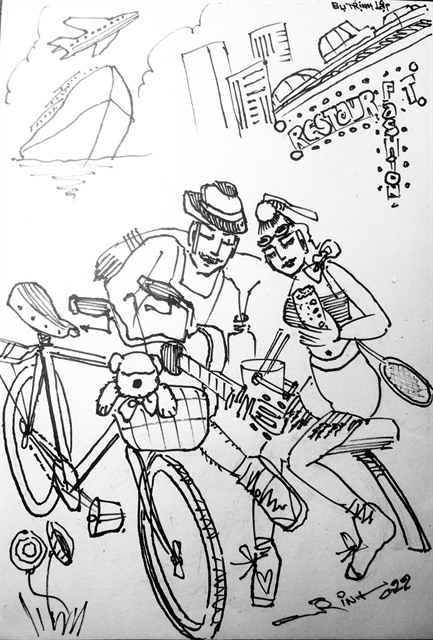
Consummerism overwhelms every aspect of life in big cities today. Illustration by Trịnh Lậ
by Nguyễn Mỹ Hà
I visited the garden and residence of President Hồ Chí Minh a few days ago as part of an on-the-job training workshop. Though we live near the compound, the last time we visited was about five years ago when we accompanied a woman swimmer to the late president's mausoleum.
I had forgotten how the garden and the fish pond could be so beautiful, refreshing and tranquil to contemplate further thoughts. The grapefruit garden bore plenty of fruit, which is harvested and presented as a gift to guests visiting the compound. The fish pond was full of fluffy golden carp that rushed up when we, with the permission of the guards, threw popcorn for them.
Every plant, vine or even root in the garden has a story to tell. The garden is a mini-world, from the house on stilts, a signature type of living of ethnic mountain people, to the two coconut trees standing in front of it or the star apple tree in the back yard where the late president used to do tai chi every morning.
Legend has it that during the long cold winter days in the north, the president used to tell his gardeners to put rice straw mixed with soft mud to wrap around the star apple tree, which was native to the warmer climate of the south. The tree survived over half a century of cold winters and now stands proud in the presidential garden, reminding everyone who steps into the garden that "the south was always in the president's heart".
The founding father of modern Việt Nam died more than 50 years ago, and you may think his modest lifestyle has become outdated with the consumerism that overwhelms every aspect of life in big cities today. City life puts much store on material wealth and abundance, but a community of young people are looking for less consumerism and more useful ways to spend their hard-earned income on more durable and eco-friendly amenities.
Many young people today keep their purchases to a bare minimum and instead boost their inner strength with meditation, quiet travel and an eco-friendly living style. They tend to look for international influencers in this matter, forgetting that their late president was actually a practitioner of a non-consumerist lifestyle and healthy daily routines.
He would do tai chi and make unannounced visits to localities, showing up in places where he was the least expected to escape formal greeting ceremonies and unnecessary speeches.
Every day about 5,000 people visit the mausoleum and garden, which is open only in the morning and closed on Monday and Friday. On National Day just a couple of weeks back, a record 70,000 people visited in one morning.
Though President Hồ wanted to be cremated in his will, for millions of Vietnamese visiting the mausoleum and seeing him lying-in-state means so much.
"I was very touched to see him," said one man in our group, a doctor at Quảng Nam provincial hospital. "It's as if I could meet him in person. I adore what he did for our country."
The simple life President Hồ led is not new to any of us. Many would say he didn't have a family, so practising thrift or leading a modest life was within reach as he depended only on himself. But it would not be so easy as the country's president, sitting at the top and still maintaining a hectic schedule and sticking with modest means.
For a dozen years, he lived within the presidential residence compound in Hà Nội and decided to first live in an electrician's house, according to the museum guide.
Later, when a wooden house was built, he moved to a two-storey structure in the garden, overlooking the gigantic ornate Presidential Palace across a hallway lined with old mango trees leading to a Buddhist temple.
When the US war of destruction against the North escalated, and a bomb fell on the street less than a kilometre away, the Politburo decided to build a bomb shelter. Designed to resist bombing, the house became the meeting room for the top leadership. The president even agreed to move downstairs to live there when his health deteriorated from late August until he passed away on September 2, 1969.
Staying true to his core values, and serving his country and people, President Hồ lived and reflected his principles.
For a multi-linguist, reading was a must. For a true reader like him, the books did not accumulate on the shelves to gather dust but were read and distributed to the relevant people to read, then shared with the wider community.
A popular saying goes, Đi một ngày đàng học một sàng khôn, literally translated as "a day's travel teaches a bucketful of wisdom". But sometimes, you don't have to look very far for the true inspiring figure to light up your world, even on a gloomy day, many years after they have passed away.
Take a morning break and walk in the shade of the presidential garden, you will not even have to visit the mausoleum nor walk up to peek into the private spaces of the late president, but you will surely walk away with profound thoughts to give you some quietude and help solve some of your own questions. VNS
OVietnam